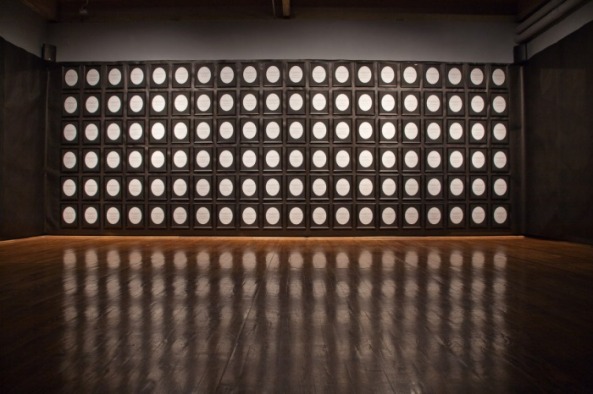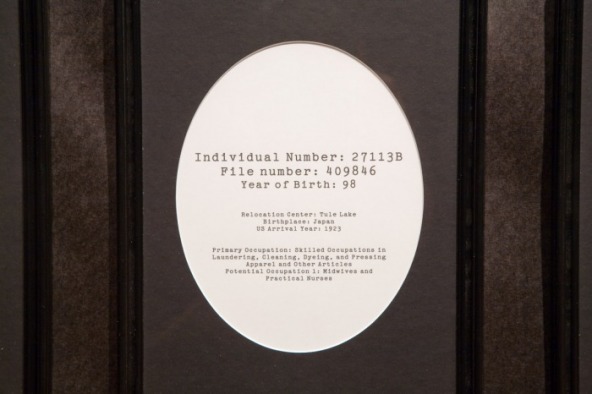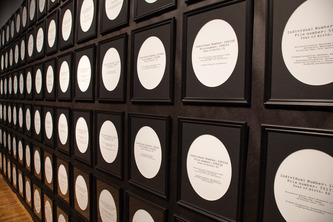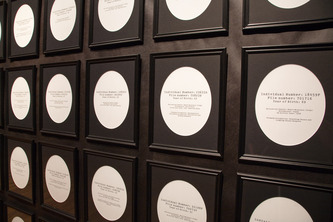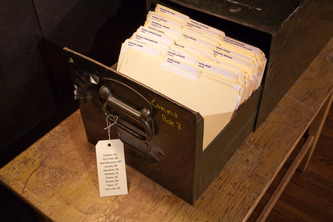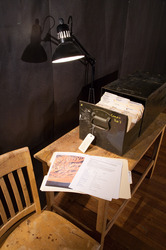"With Liberty and Justice for Some"
Installation images photographed by Kirkman Amyx
With Liberty and Justice for Some
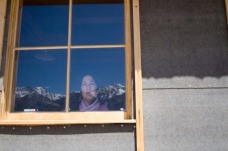
At one time in my life, I believed in the words of the Pledge of Allegiance, particularly “with liberty and justice for all.” Then around the age of nine, I learned of the incarceration of my parents and grandparents in relocation camps during WWII based solely on their ethnicity and fueled by fear. The irony of those words from the Pledge of Allegiance was not lost upon me, even at a young age. The incarceration of approximately 120,000 West Coast Japanese, with two-thirds of them being American born citizens of the United States, was a travesty of justice. Roughly thirty-five years later, I discovered the public government archive records from the War Relocation Authority (WRA). The WRA gathered information on the West Coast Japanese Americans rounded up during WWII with their individual numbers assigned to them like prisoners. Both my parents, grandparents, and other relatives were placed in these “relocation” camps. Data gathered on each individual ranged from place of birth, year of birth or arrival in the US to potential, mostly servile, occupations. Each person was also assigned an individual number as well as a file number. Former prisoner and artist Miné Okubo wrote a book about her experience in the camp called “Citizen 13660.” The book was named after the assigned prisoner number Miss Okubo was given during her incarceration.
''The number was on suitcases and everything you owned, all the papers you signed,'' she recalled. ''You became a number.''
The picture frames against the tar papered wall contain textual portraits of people from information gleaned from the WRA records. Without names, only their numbers and other select information from the records will be displayed. The information is matted with the traditional portrait mat to signify that these “numbers” are people. The dehumanized portrait is representative of how the US government saw them. The listing of assigned numbers without names provides a narrative framework to my Japanese American cultural memory and references the sociopolitical and historical issues of the subjugation and injustice experienced by Japanese Americans during WWII. The archived files placed on the table opposite the frames in the gallery, re-humanizes the individuals represented in the frames, documents events in their life or death, accomplishments and contributions during and after the camps. The whispered reading of the names of those on the wall with the sound moving about the room references the past event and people not to be forgotten.
I am interested in the construction of my identity and the ways in which my identity it is both inherited and reconstructed through the geo-historical perspective of the West Coast Japanese American experience of the last century. My art wells from the intersection of politics and the exploration of my identity within the base of my cultural-historical background. The historical and personal information and experiences of my family informs my work and shapes the manner in which it is conceived, constructed and created.
2009
(Manzanar Barrack Photo by Danny Lulu, 2009)
''The number was on suitcases and everything you owned, all the papers you signed,'' she recalled. ''You became a number.''
The picture frames against the tar papered wall contain textual portraits of people from information gleaned from the WRA records. Without names, only their numbers and other select information from the records will be displayed. The information is matted with the traditional portrait mat to signify that these “numbers” are people. The dehumanized portrait is representative of how the US government saw them. The listing of assigned numbers without names provides a narrative framework to my Japanese American cultural memory and references the sociopolitical and historical issues of the subjugation and injustice experienced by Japanese Americans during WWII. The archived files placed on the table opposite the frames in the gallery, re-humanizes the individuals represented in the frames, documents events in their life or death, accomplishments and contributions during and after the camps. The whispered reading of the names of those on the wall with the sound moving about the room references the past event and people not to be forgotten.
I am interested in the construction of my identity and the ways in which my identity it is both inherited and reconstructed through the geo-historical perspective of the West Coast Japanese American experience of the last century. My art wells from the intersection of politics and the exploration of my identity within the base of my cultural-historical background. The historical and personal information and experiences of my family informs my work and shapes the manner in which it is conceived, constructed and created.
2009
(Manzanar Barrack Photo by Danny Lulu, 2009)
Proudly powered by Weebly
